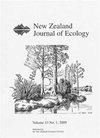No evidence for sampling bias caused by capture method or time in Apteryx mantelli
IF 1.4
3区 环境科学与生态学
Q3 ECOLOGY
引用次数: 0
Abstract
: Sampling bias can have dire consequences for research. One potential source of bias is combining different sampling methods in the same study. However, combining methods can be unavoidable, for instance, when sampling method selection depends upon factors such as population density or terrain. A case at hand is the use of night-time encounter catching by people or daytime catching using certified dogs for studies of Apteryx mantelli , North Island brown kiwi, in Aotearoa New Zealand. Here, we compare these sampling methods to determine whether (1) combining them risks inducing a demographic bias to the sample set, and (2) they differ in regards to blood parameters used for comparing populations (packed cell volume, glucose, plasma protein, haemoglobin). Sixty-five birds were caught during the day from their roosts using a certified dog, and 62 birds were caught at night while foraging. The results suggest that both methods capture a comparable subset of a population, with the potential exception that more very young juveniles were caught using the day method. Furthermore, no physiological effects were evident from comparing haematological parameters. We also found no difference in blood sampling success between night and day, but observed that blood extraction was more difficult at night. Hence, we demonstrate that either method, or a combination of both, can be considered for future studies. Notably, we found that night-time encounter catching had a superior success rate in very high-density populations. Since this method also negates dependency on the limited number of certified dogs, we suggest that benefits may exist through increasing the utilisation of night-time encounter catching in A. mantelli research. We suggest that future studies should consider measuring the stress levels caused by each of the methods, and quantify the effects of habitat type and terrain on sampling success.没有证据表明在manteryx中捕获方法或时间造成了抽样偏差
:抽样偏差可能会对研究产生可怕的后果。一个潜在的偏差来源是在同一项研究中结合不同的采样方法。然而,组合方法可能是不可避免的,例如,当采样方法的选择取决于人口密度或地形等因素时。目前的一个案例是,在新西兰奥特亚的北岛棕色猕猴桃Apteryx mantelli的研究中,人们使用夜间偶遇捕捉或白天使用认证狗捕捉。在这里,我们比较了这些采样方法,以确定(1)将它们组合在一起是否有可能导致样本集的人口统计学偏差,以及(2)它们在用于比较人群的血液参数(堆积细胞体积、葡萄糖、血浆蛋白、血红蛋白)方面是否不同。白天用一只经过认证的狗从栖息地捕获了65只鸟,晚上在觅食时捕获了62只鸟。结果表明,这两种方法都捕捉到了一个相当的种群子集,但可能的例外是,使用日间方法捕捉到了更多非常年轻的青少年。此外,比较血液学参数没有明显的生理影响。我们还发现,夜间和白天的采血成功率没有差异,但观察到夜间采血更困难。因此,我们证明,任何一种方法,或两者结合,都可以考虑用于未来的研究。值得注意的是,我们发现,在高密度人群中,夜间相遇捕捉的成功率更高。由于这种方法也否定了对有限数量认证狗的依赖,我们认为,在A.mantelli的研究中,通过增加夜间偶遇捕捉的利用率,可能会带来好处。我们建议,未来的研究应该考虑测量每种方法造成的压力水平,并量化栖息地类型和地形对采样成功的影响。
本文章由计算机程序翻译,如有差异,请以英文原文为准。
求助全文
约1分钟内获得全文
求助全文
来源期刊

New Zealand Journal of Ecology
环境科学-生态学
CiteScore
3.00
自引率
12.50%
发文量
35
审稿时长
>36 weeks
期刊介绍:
The New Zealand Journal of Ecology is a biannual peer-reviewed journal publishing ecological research relevant to New Zealand/Aotearoa and the South Pacific. It has been published since 1952 (as a 1952 issue of New Zealand Science Review and as the Proceedings of the New Zealand Ecological Society until 1977). The Journal is published by the New Zealand Ecological Society (Inc.), and is covered by Current Contents/Agriculture, Biology and Environmental Science, GEOBASE, and Geo Abstracts.
 求助内容:
求助内容: 应助结果提醒方式:
应助结果提醒方式:


